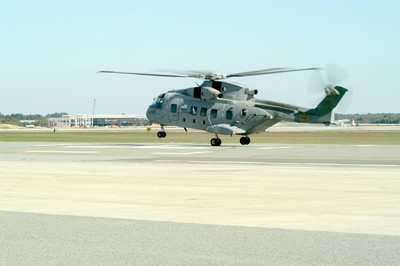Cost Has Skyrocketed To $11.2 Billion
Six years after the White House called for a more advanced fleet
of presidential transport helicopters, the program tasked with that
mission is facing increased questions, and an uncertain future.

The Washington Post reports Lockheed Martin and its British
partner, AgustaWestland, is in jeopardy of losing the US101
helicopter contract, which called for delivery of 28 highly
advanced VH-71 helicopters, to replace the current fleet of
Sikorsky VH-3D and VH-60N helicopters. As ANN reported, the Pentagon
awarded Lockheed the contract in 2005, on the strength of the
three-engine design of the AgustaWestland EH101 on which the VH-71
is based.
Those were the days. Since then -- and this is going to sound
familiar to anyone who follows military procurement issues,
especially programs like the Joint Strike Fighter -- the cost of
the entire VH-71 program has skyrocketed to $11.2 billion... and
the Pentagon has yet to see its first helicopter.
Such delays and overages have become so common, in fact, there's
even a term for it: "mission creep."

The VH-71 is intended to carry up to 14 people farther distances
than existing presidential helicopters, without refueling, while
carrying such advancements as antimissile defenses, armored
fuselage reinforcements, and communications gear intended to keep
the President in contact with top advisors during moments of
crisis... such as the events of 9/11, which prompted the call for a
more advanced transport.
Typically, the President only spends minutes onboard Marine One;
the helicopters' prime duty is to ferry the president and other
officials to and from Air Force One, the presidential 747.
And speaking of Air Force One... the per-unit cost of each VH-71
surpasses that of the specialized 747s in 1990, even when adjusted
for inflation. But one shouldn't focus on the pricetag, says former
undersecretary of defense for acquisition Jacques Gansler. "You
don't think of it in terms of what's the cost of the individual
helicopter," he told the Post. "You think of it as, what do we need
to do to protect the president?"

But cost does factor into it. As ANN reported in January,
there are rumors the entire project faces imminent cancellation,
due to the cost and development overruns.
Lockheed declined to comment on the matter, but has told program
supporters the US Navy added some 1,900 additional requirements
since the contract was awarded -- hence the delays in completing
the first VH-71s, and the added costs.
There's just one problem with that logic -- Lockheed's claims
are news to the Navy. "It's not the truth," said Navy spokeswoman
Stephanie Vendrasco. "And we can't figure out where that [1,900]
number comes from. It's a myth, and it's becoming a legend."
Vendrasco admitted, however, that planners didn't understand all
the demands on the VH-71 at first... a sentiment echoed by John J.
Young Jr., the current undersecretary of defense for
acquisition,
"The Navy and industry team did not clearly realize the full
implications of the White House requirements," he told the Post,
adding "the Navy and industry teams are having to complete
substantial redesign" of the EH101, to meet the VH-71 mission.
"This redesign work is driving significant cost growth into the
program."
Vendrasco attributes the issues, in part, to an attempt to
accelerate VH-71 development by three years. "There was just a slow
start out of the gate," she said. "And schedule is money."

For now, the first three VH-71s are due for delivery in 2010,
one year behind schedule, and the Navy had to accept compromises
with those helicopters in order to meet that timeframe. The
remaining 23, fully-equipped aircraft will come later... though the
original target of 2015 for those deliveries has slipped to an
unknown date, due to problems.
And that means retirement dates for the current Marine One fleet
are also on hold. The oldest VH-3Ds have flown US presidents for 33
years.
 ANN's Daily Aero-Term (12.01.25): Convective SIGMET
ANN's Daily Aero-Term (12.01.25): Convective SIGMET ANN's Daily Aero-Linx (12.01.25)
ANN's Daily Aero-Linx (12.01.25) NTSB Final Report: Remos Aircraft GmbH Remos GX
NTSB Final Report: Remos Aircraft GmbH Remos GX Aero-News: Quote of the Day (12.02.25)
Aero-News: Quote of the Day (12.02.25) ANN's Daily Aero-Term (12.02.25): Coupled Approach
ANN's Daily Aero-Term (12.02.25): Coupled Approach






